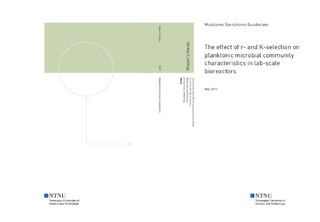| dc.contributor.advisor | Vadstein, Olav | |
| dc.contributor.advisor | Bakke, Ingrid | |
| dc.contributor.author | Gundersen, Madeleine Stenshorne | |
| dc.date.accessioned | 2019-10-12T14:00:48Z | |
| dc.date.available | 2019-10-12T14:00:48Z | |
| dc.date.issued | 2019 | |
| dc.identifier.uri | http://hdl.handle.net/11250/2621728 | |
| dc.description.abstract | Miljøer med tilgjengelige ressurser, tomme nisjer og mye plass selekterer for r-strategiske organismer som har høye maksimale vekstrater. K-strateger, derimot, har høyere substrat affinitet og utnyttelses effektivitet, som gjør de konkurransedyktige i miljøer der biomassen er nær eller ved miljøets bæreevne. I land-baserte oppdrettsanlegg har seleksjon for K-strateger, K-seleksjon, resultert i bakteriesamfunn med høyere diversitet, økt temporal sammensetnings stabilitet og reduksjon i mengden potensielle patogene bakterier.
Hensikten med denne oppgaven var å utforske hvordan r- og K-seleksjon påvirket det planktoniske bakteriesamfunnet i sjøvann, og om bæreevnen påvirket utfallet. Dette ble studert i et 2x2 faktorialt krysningsforsøk, med tre replikaer, over syv uker, med et bytte i r- og K-seleksjon etter fire uker. De bakterielle samfunnene ble analysert med flowcytometri og Illumina sekvensering av de variable regionene V3 og V4 i 16S rRNA genet.
K-selekterte samfunn hadde høyere bakteriell tetthet og lavere gjennomsnittlig RNA innhold enn r-selekterte samfunn. Det var ingen store forskjeller i alfa-diversitet av orden en over tid mellom seleksjonsregimene, selv om det var antydning til at K-seleksjon økte jevnheten i samfunnene. Alpha- og Gamma-proteobacteria dominerte i samfunnene. Mengden Gamma-proteobacteria økte under r-seleksjon, mens Alpha-proteobacteria økte under K-seleksjon. Noen få slekter utgjorte majoriteten av samfunnene, og seleksjonsregimene påvirket forekomsten til mange av disse. Vibrio og Colwellia konkurrerte godt under r-seleksjon, mens Roseovarius var den beste konkurrenten under K-seleksjon. Over tid ble bakteriene i samfunnene mer fylogenetisk like, som tydet på en konstant seleksjon for bakterier med høy fitness til den eksperimentelle situasjonen. Den temporale sammensetnings stabiliteten sank under K-seleksjon. Likevel utviklet replikaene innad i et seleksjonsregime seg relativt likt, som indikerte et sterkt deterministisk suksesjonsmønster. En interessant observasjon var at Vibrio, en slekt med mange marine patogene stammer, ble utkonkurrert i alle reaktorer under K-seleksjon. Dette støtter hypotesen om at K-seleksjon er en god strategi for styring og kontroll av bakterielle samfunn i land-baserte oppdrettsanlegg. | |
| dc.description.abstract | Uncrowded environments with resources in surplus and empty niches select for r-strategic organisms that have high maximal growth rates. K-strategists, on the other hand, have higher substrate affinity and utilisation efficiency, making them better competitors in environments where the biomass is close to or at carrying capacity. Selection of K-strategists, or K-selection, has in land-based aquaculture systems yielded communities with higher diversity, increased temporal compositional stability and reductions in the abundance of possible pathogenic bacteria.
The objective of this thesis was to explore how r- and K-selection affected the community characteristics of planktonic seawater Bacteria at two different carrying capacities. A 2x2 factorial crossover experiment, with three replicates, was run for seven weeks with a switch in r- and K-selection after four weeks. The bacterial communities were analysed using flow cytometry and Illumina sequencing of the V3 and V4 variable regions of the 16S rRNA gene.
K-selected communities had higher bacterial densities and lower mean RNA content than r-selected ones. The differences in alpha-diversity of order one between the selection regimes were not substantial, although K-selection appeared to increase the evenness. Alpha- and Gamma-proteobacteria dominated the communities. During r-selection, Gamma-proteobacteria increased in abundance, while Alpha-proteobacteria increased during K-selection. A few genera made up the majority of the communities. Vibrio and Colwellia competed well during r-selection, while Roseovarius was the best competitor during K-selection. On the temporal scale, the community members became more phylogenetically similar, indicating an overall selection of bacteria with high fitness to the experimental situation. The temporal stability in community composition decreased during K-selection. However, the replicates within a selection regime developed in a similar way, indicating a strong deterministic succession pattern. An exciting observation was that Vibrio, a genus with many known marine pathogens, was out-competed in all reactors during K-selection. This supports the hypothesis that K-selection is a good strategy for the management of microbial communities in land-based aquaculture. | |
| dc.language | eng | |
| dc.publisher | NTNU | |
| dc.title | The effect of r- and K-selection on planktonic microbial community characteristics in lab-scale bioreactors | |
| dc.type | Master thesis | |
